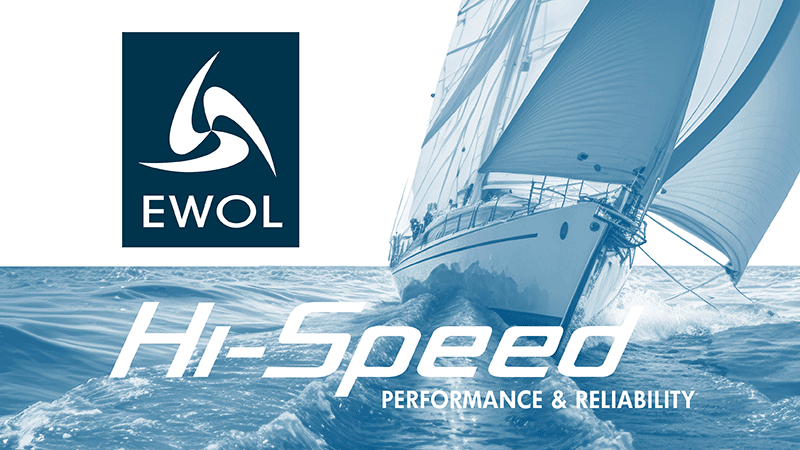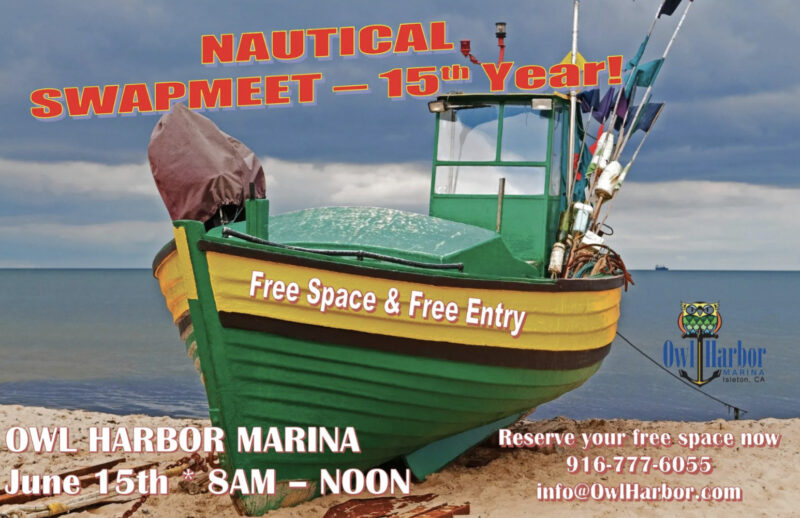
Hey, ‘Presto!’ This Pacific Cup Entrant Intends To Race to Hawaii Quickly
Presto! Translated into English, this Italian word is generally taken to mean “quickly.” We’re therefore guessing that is how Sue and Joe Dazey of the 48-ft Chris White-designed catamaran Presto like to sail. And according to crewmember Nicole Miller from San Francisco, Presto is one of only two multihulls in this year’s Pacific Cup, the other being the Simonis 53 custom catamaran Could Be Worse.
“It’s a great boat with superb skippers and dedicated crew,” Nicole tells us.
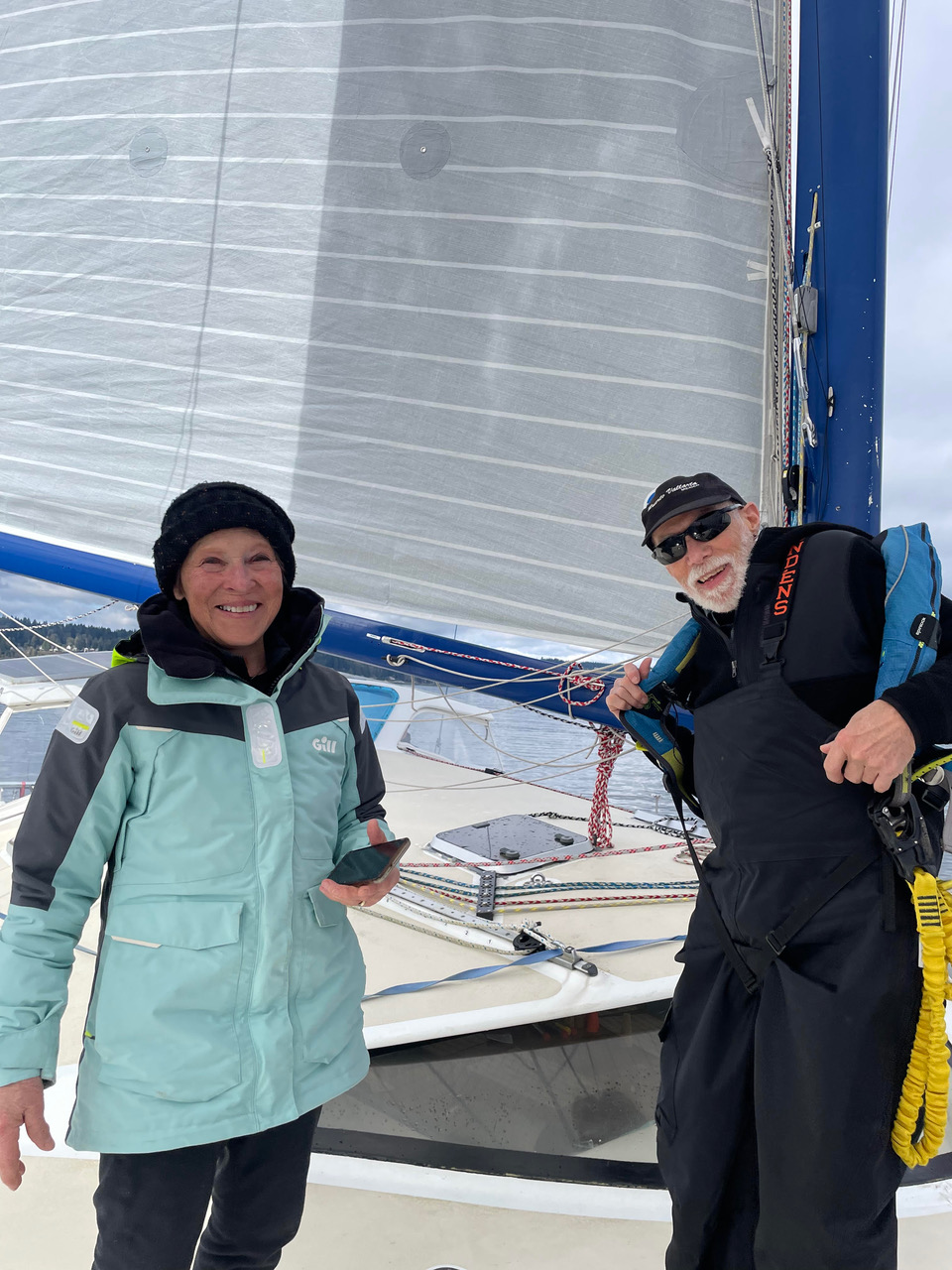
Presto’s skippers Sue and Joe Davey hail from Washington state and have owned their catamaran since 2015. Between them they have over 15,000 miles of coastal and ocean sailing, racing, and cruising under their keels. They’ve sailed the Salty Dawg Rally a couple of times, and sailed from Chesapeake Bay to Florida and the Caribbean, to Costa Rica, the Panama Canal, Mexico and back up to Seattle. They are active members of the Pacific Northwest Multihull Society and regularly sail and race in the Seattle area. They’re also planning to join the YRA’s Half Moon Bay Regatta at the end of June before the Pac Cup in July.
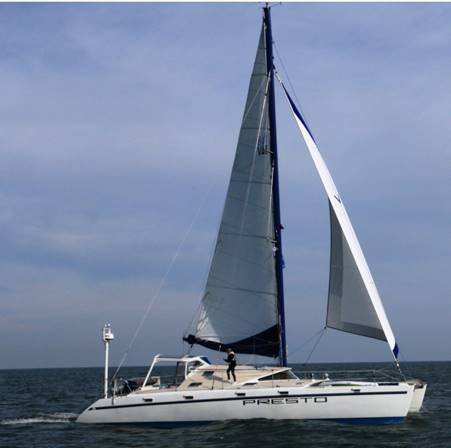
Nicole, 54, tells us Sue and Joe, who are on the other side of 75, have been sailing together for more than 40 years after meeting through sailing mulithulls. In 1981, they sailed up to Alaska, fell in love with it, and started commercial trolling for salmon out of Sitka, AK.
Other crew for Presto’s race to Hawaii are Ben Carver, a multihull champion from the East Coast whom Joe and Sue met in the Chesapeake and who now lives in Seattle, and Galen Loving, an avid sailor who lives in Berkeley with his family.
We’ll share Nicole’s sailing story in ‘Lectronic next week. But for now, we’ll say that between Nicole and her husband she is the sailor and races regularly out of South Beach. “I sometimes joke that I don’t have to ask the wife if I can go sailing — I am the wife.” Stay tuned!
Support Latitude 38’s commitment to West Coast sailors and sailing news here.
SSS Singlehanded Farallones Race: Foggy, Unfinishable
On May 11, the Singlehanded Sailing Society’s Singlehanded Farallones race had most of the ingredients for a great day: a classic course out the Gate, a good ebb at the start to help boats get under the bridge, a 16-hour time limit, and a good flood before the midnight cutoff to help boats get back. Missing were visibility in the heavy fog, and wind. Fourteen boats started. No boats finished, with the most persevering only getting back in the Gate around 11 p.m.
Sean Mulvhill of the J/120 Jamani said, “It was an unusual Farallones race Saturday, with 12 knots of southwest wind getting out of the Bay, dense fog, and progressively lighter wind out to the Lightship.The expected building northwest wind did not make an appearance. Jamani retired at 2:30, leading the pack but still 12 miles from the SE Farallon mark. The dense fog in the Bay and out beyond Mile Rock made navigation by GPS and attention to nearby vessels by AIS crucial. Despite the gloomy weather, it was a good day on the water.”
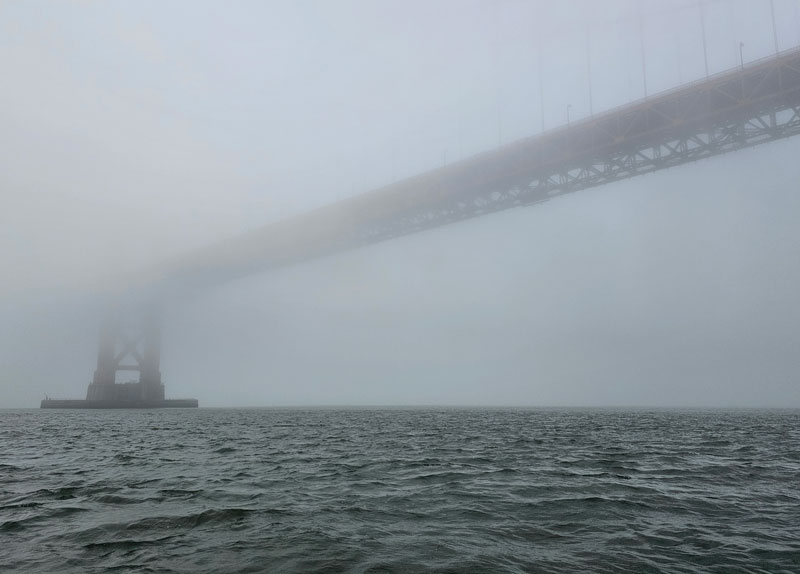
The morning started with heavy fog coming in, especially on the north side of the Central Bay. The Coast Guard reported visibility of a quarter mile in the Bay, and one tenth of a mile outside. Asked about the tenth-mile visibility, Sean Mulvhill reported, “Yes, or even less at Mile Rock. Much better at the Lightship and beyond. Glassy water and light winds beyond the Lightship.” Greg Nelsen, skipper of the Azurra 310 Outsider, retired with the message: “No issue, just no visibility past the bow until back near Bonita.”
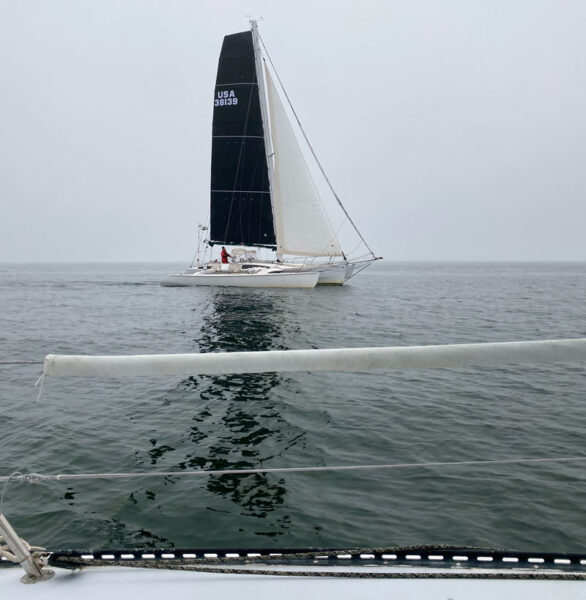
Truls Myklebust of the Explorer 44 trimaran Caliente said, “We had a decent breeze to start, to get us out past Point Bonita. Then we had a really light stretch in dense fog around the ship channel. Several boats turned back there. However, we eventually got some breeze, and had a very pleasant sail out past Duxbury Reef with Greyhound, Jamani and Werewolf after the dense fog had lifted. However, that breeze eventually died out. The forecast afternoon breeze never filled in, so it eventually became clear that we wouldn’t be able to make it around the island and back in time.”
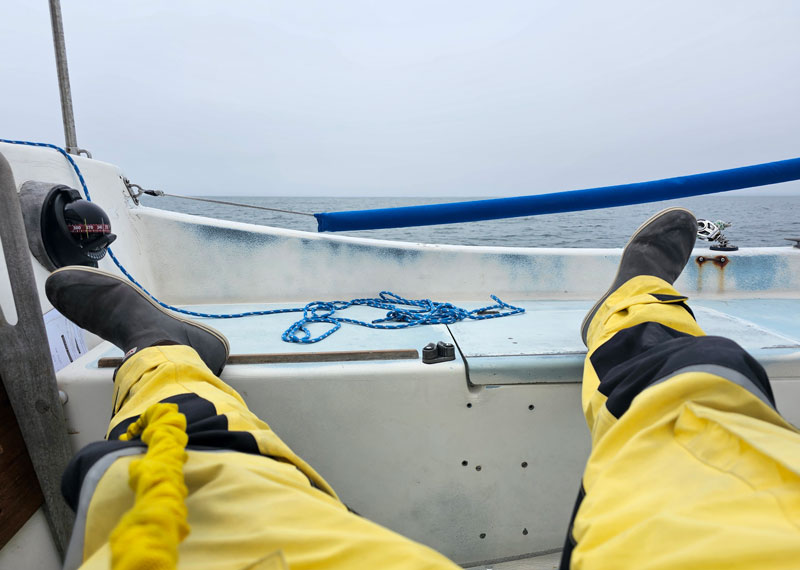
The farthest-west boats were at most a mile or two past the northern approach buoy when they turned around.
As often happens when it is light on the ocean, it was gusty when the retiring boats re-entered the Bay. Evan McDonald of the F-22 trimaran Greyhound said, “It went from low wind to solid 24 gusting to 28 in the Slot.”
This was the first race where the SSS required all boats to have AIS transponders. Effective 2024, the SSS board determined that, consistent with the YRA’s requirements for offshore races and US Sailing and other bodies’ requirements for coastal races, SSS would require AIS transponders for its coastal and ocean races. This includes the next SSS Singlehanded Transpacific race to Hawaii, scheduled for June 2025.
“After the heavy fog at last year’s Singlehanded Farallones, the SSS board took a hard look at an AIS requirement,” said the race committee. “Given the SSS’s emphasis on safety, seamanship and independence, which includes an eye on frugality, this was not an easy decision. The board’s cost/benefit analysis resulted in strong feedback from our fiercely independent group of serious sailors.”
Truls Myklebust on Caliente said, “We had an AIS incident even before the race started. One of the boats was on the way to the start line in heavy fog, and crossed the deep-water shipping lane in front of an outgoing container ship. AIS made the boat visible to the ship, and the Coast Guard tried to hail her on VHF 16. I recognized the boat name, and hearing no response, suggested they try the race channel instead. They were able to reach the boat and avoid a collision.”
In the first 90 minutes of the race, two container ships and two Coast Guard cutters hailed or phoned the race committee in the foggy conditions. The second cutter hailed, “Flotilla leader, where are your vessels?” AIS provided the race committee with an answer, reducing stress and risk for all involved.
As the race ended in the dark, a tug moving 10 knots through the Gate used AIS to detect an inbound racer proceeding at 5 knots in the outbound lane. The tug hailed VTS for permission to divert to the inbound lane and talked to the inbound vessel, making for a professionally handled non-event.
Discover EWOL Performance Propellers
Alameda Marina’s “Svendsen Maritime Park” Is One Step Closer
Svend Svendsen was a Bay Area legend — a sailor and a businessman, he passed in 2013. Svend and his wife Suzanne founded Svendsen’s Boat Works in Alameda in 1963. He was a member of the St. Francis YC, and was named the club’s Yachtsman of the Year in 2004. Svend Svendsen was also known as the Godfather of Folkboats and is credited with preserving the Folkboat class by ushering in the transition from wood to fiberglass construction.
In March we wrote about the community’s effort to name Alameda Marina’s new park “Svendsen Maritime Park” in Svend’s honor and memory. At that time Svend’s daughter Sabrina had reached out to us to share the story, with the hope of reaching more people and garnering more support for the proposal when it goes before the Alameda City Council. Well, we now have a date for the proposal to be heard before the council — Tuesday, May 21, at 7:00 p.m.
The item is listed as number 7a on the City of Alameda’s meeting agenda. Sabrina is asking anyone who would like to support the naming to please attend the meeting, either in person or via Zoom, or send an email to the council at [email protected]. You could also include Sabrina in your email: [email protected].
The council meeting will be held at City Hall, 2263 Santa Clara Avenue, Council Chambers, 3rd Floor, Alameda, CA, 94501. You can attend in person, or via Zoom using this link.
The council has also published a guide on How to Participate in Public Meetings.
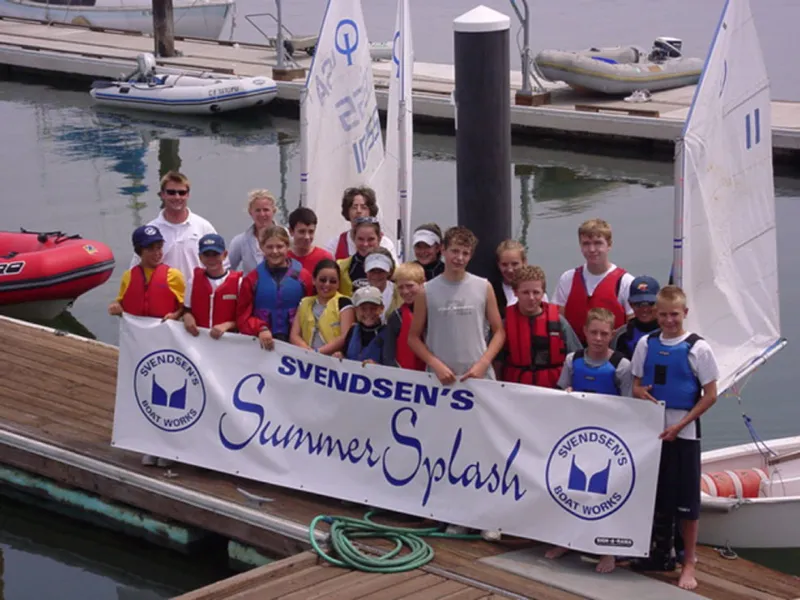
As we wrote in our previous story, “We have a chance to name the new park at Alameda Marina “Svendsen Maritime Park,” in honor of Svend Svendsen and the legacy of Svendsen’s Boat Works. If you have stories or memories of how Svend or the boat works made a difference in the community, in innovation, or in your life, we’d love to hear them. Your stories can help ensure the park carries a name that reflects the true spirit of Alameda’s maritime heritage.
“Thank you so much for your help in honoring Svend!” — Sabrina.
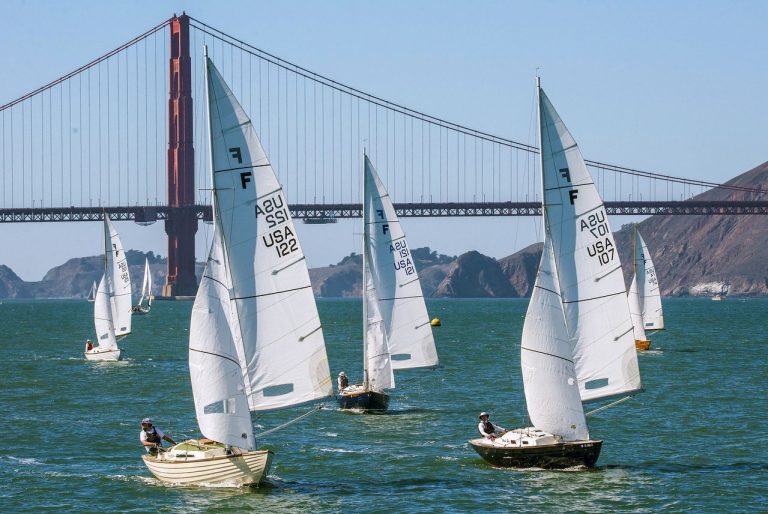
Want to make a friend smile? Give them a gift subscription to Latitude 38.
With the A’s Out of Estuary Picture, What’s Plan B for Oakland Waterfront Development?
After the Oakland A’s abandoned their plans to build a new stadium on the Estuary — and as the A’s “B-line” it for Las Vegas, via Sacramento — a political vacuum has settled on the waterfront, with a continuing debate over Oakland’s waterfront development, infrastructure (via the proposed pedestrian bridge), and what will bring the most money to Jack London Square. Maritime advocates have discussed “advancing the industrial waterfront,” while Oakland’s mayor said that a section of the Port is still open to development, at least in theory.
“Departing sports teams and frustrating politics haven’t detracted from the elegance of Oakland’s waterfront — a gleaming reminder that, despite its troubles, the city and its bustling port remain a cultural and economic cornerstone of the Bay Area,” the Las Vegas Sun/Mercury News wrote earlier this week. “But for years, Oakland has struggled to establish a large-scale vision to place the waterfront — with its nightlife hub at Jack London Square and the industrial harbor a short walk away — at center stage in the city’s attractions.”
The ballpark is “officially dead” according to the Sun, though it’s been unofficially dead for at least a year.
“In the wake of the city’s divorce from the A’s, Mayor Sheng Thao had said the Howard Terminal property was still ripe for any developer who wanted to step forward,” the Sun reported. “Oakland had cleared multiple regulatory hurdles and raised nearly $260 million to support some kind of public-facing real estate there, Thao had reminded the public.”
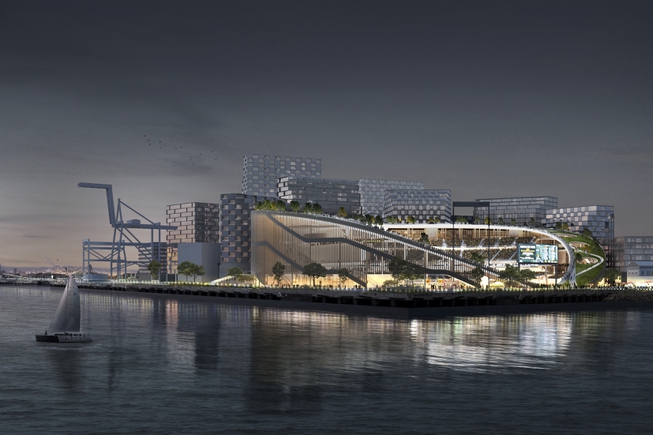
However, the Bay Conservation and Development Commission, or BCDC, re-designated Howard Terminal for “port priority use” last month, after they’d changed that status in 2022 to “other purposes,” which cleared the way for the proposed stadium to move forward. The malleability of the port’s designation makes it seem as if the laws and regulations on the books can be changed at the whim of whatever development is on the table. What’s the point of having a designation if you can just flip it like a switch?
As a result of the re-re-designation, “Oakland likely won’t have any housing or commercial real estate built right up against the Bay waters any time soon — especially when there isn’t a major professional sports franchise leading the charge behind a development,” the Sun wrote.
So what does Howard Terminal’s, and the Port’s, future look like?
“In March, private shipping industry groups developed a summary of how they’d instead like to ‘advance the industrial waterfront.’ Charging stations for electric-powered trucks and offshore wind energy projects ranked near the top of the list. An industry representative said there’s some wiggle room for other plans, but not a lot,” the Sun reported. “‘We were philosophically opposed to giving up the property for’ the A’s development, said Mike Jacob of the Pacific Merchant Shipping Association, ‘but as a practical matter, we were interested in sitting down to (discuss) seaport compatibility with a ballpark and not housing. It would’ve smoothed the path toward some non-maritime redevelopment.'”
The Sun said that Jack London Square and waterfront business owners said the district is “mostly faring well but could use a significant boost in foot traffic, given that it is cut off from downtown Oakland by I-880. On an average weekday afternoon, the Bay-facing Jack London Square is somehow both scenic and full of businesses — but also noticeable for its relative quiet. Mostly empty walkways are filled by seagulls.”
A co-owner of Heinold’s First and Last Chance Saloon said, “If you want more bustle, you need to do something with the square other than restaurants and bars. People need something else to do.”
What’s clear, if not absurdly obvious, is that there is no unified vision for the Oakland waterfront. Maybe there is a document out there with economic targets for Jack London Square, possible options outside of a new ballpark, and input from various interest groups on what they’d like. Or maybe the city is reactive instead of proactive and simply hurtles from proposal to proposal. It’s not clear how the proposed pedestrian bridge spanning the Estuary would fit into this unified economic vision — the bridge is seen more as a facilitator of environmental and social goals rather than economic ones.
While Latitude 38 has long been happy to speculate on the disfunction of government, here’s a legitimate question: What lessons have been learned from other cities around the world? Where’s the document outlining what has worked, and what has failed, on other waterfronts?
Where’s the learning curve?
Thinking of Heading to the Pacific Sail & Power Boat Show? Do It!
The Pacific Sail & Power Boat Show is open and ready for visitors. Marine businesses and organizations have set up their booths and filled them with sailing goodies to show and demonstrate across the weekend. We arrived yesterday and set up our booth, then went off to see who else was there with us.
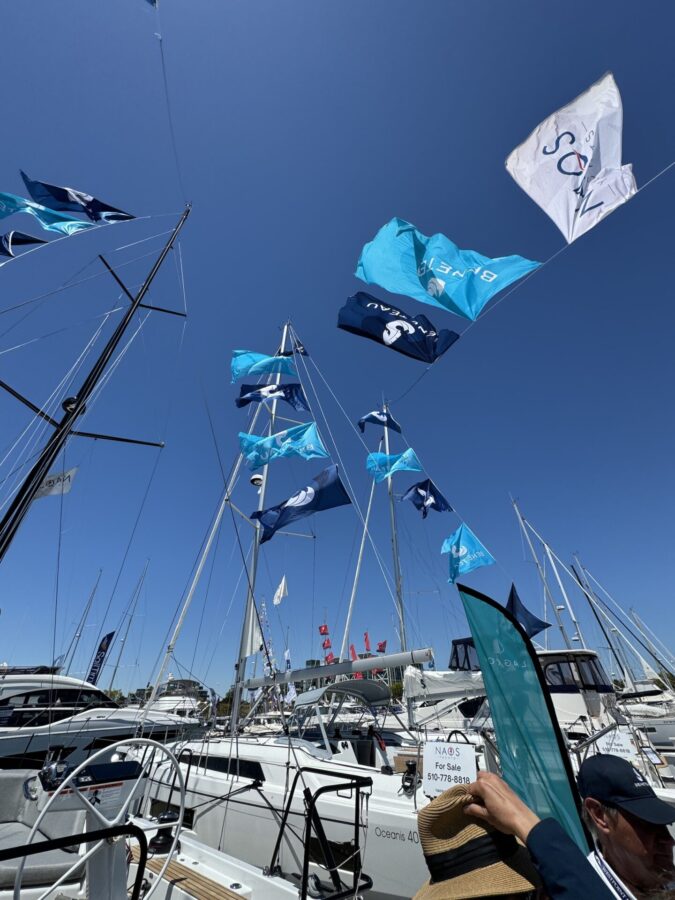
Above is only a small sample of the who’s who of the show. Come on down and see for yourself!
Show times:
Thursday and Friday from 11 a.m. to 6 p.m.
Saturday from 10 a.m. to 6 p.m.
Sunday from 10 a.m. to 5 p.m.
Admission is $20 for adults; children 12 and younger are free, and active military personnel enjoy complimentary admission on Thursday and Friday. Purchase advance tickets at www.PacificBoatShow.com.
Owl Harbor’s 15th Annual Nautical Swapmeet
Reserve space now by calling (916) 777-6055 or email [email protected].

